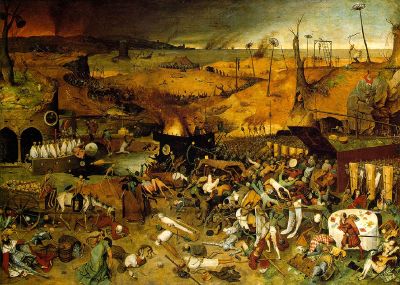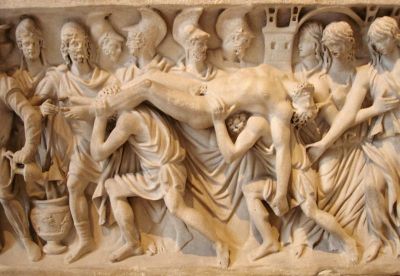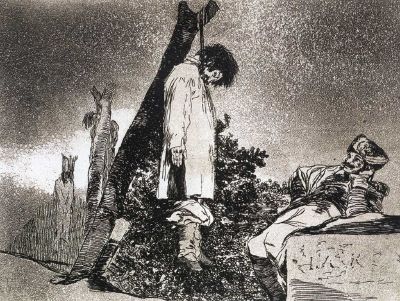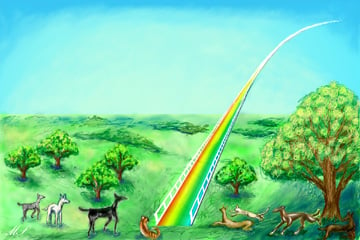Death
Death is the permanent end of the life of a biological organism. Death may refer to the end of life as either an event or condition. Many factors can cause or contribute to an organism's death, including predation, disease, habitat destruction, senescence, malnutrition, and accidents. The principal causes of death in developed countries are diseases related to aging. In medicine, biological details and definitions of death have become increasingly complicated as technology advances.
Traditions and beliefs related to death are an important part of human culture, and central to many religions. Nearly every culture has had some belief in an afterlife, some form of continued existence after the death of the human body. While science has lacked the technology to find scientific evidence of such existence, faith and personal experience provide support and comfort for many who understand the purpose of our life to transcend our bodies.
Whatever one's belief about death, as it draws near, its finality provides a perspective upon one's entire lifetime. For many people, how one dies is as important as how one lived. Hence people regard it of great importance to take care of unfinished matters and reconcile with loved ones in preparation for death.
Definition
Historically, attempts to define the exact moment of death have been problematic. Death was once defined as the cessation of heartbeat (cardiac arrest) and of breathing, but the development of CPR and prompt defibrillation have rendered the previous definition inadequate because breathing and heartbeat can sometimes be restarted. This is now called "clinical death." Events which were causally linked to death in the past no longer kill in all circumstances; without a functioning heart or lungs, life can sometimes be sustained with a combination of life support devices, organ transplants, and artificial pacemakers.
Today, where a definition of the moment of death is required, doctors and coroners usually turn to "brain death" or "biological death": People are considered dead when the electrical activity in their brain ceases (unlike a persistent vegetative state). It is presumed that a stoppage of electrical activity indicates the end of consciousness. However, suspension of consciousness must be permanent, and not transient, as occurs during sleep, and especially a coma. In the case of sleep, EEGs can easily reveal the difference. Identifying the moment of death is important in cases of transplantation, as organs for transplant must be harvested as quickly as possible after the death of the body.
The possession of brain activity, or ability to resume brain activity, is a necessary condition to legal personhood in the United States: "It appears that once brain death has been determined … no criminal or civil liability will result from disconnecting the life-support devices."[1]
Those maintaining that only the neo-cortex of the brain is necessary for consciousness sometimes argue that only electrical activity there should be considered when defining death. Eventually it is possible that the criterion for death will be the permanent and irreversible loss of cognitive function, as evidenced by the death of the cerebral cortex. All hope of recovering human thought and personality is then gone. However, at present, in most places the more conservative definition of death—irreversible cessation of electrical activity in the whole brain, as opposed to just in the neo-cortex—has been adopted (for example the Uniform Determination Of Death Act in the United States).
Even by whole-brain criteria, the determination of brain death can be complicated. EEGs can detect spurious electrical impulses, while certain drugs, hypoglycemia, hypoxia, or hypothermia can suppress or even stop brain activity on a temporary basis. Because of this, hospitals have protocols for determining brain death involving EEGs at widely separated intervals under defined conditions.
Biology
Fate of dead organisms
After death an organism's remains become part of the biogeochemical cycle. Animals may be consumed by a predator or scavenger. Organic material may then be further decomposed by detritivores, organisms which recycle detritus, returning it to the environment for reuse in the food chain. Examples include earthworms, woodlice and dung beetles. Microorganisms also play a vital role, raising the temperature of the decomposing material as they break it down into simpler molecules. Not all material need be decomposed fully however; for example coal is a fossil fuel formed in swamp ecosystems where plant remains were saved by water and mud from oxidization and biodegradation.
In animals, small movements of the limbs (for example twitching legs or wings) known as a postmortem spasm can sometimes be observed following death. Pallor mortis is a postmortem paleness which accompanies death due to a lack of capillary circulation throughout the body. Algor mortis describes the predictable decline in body temperature until ambient temperature is reached. Within a few hours of death rigor mortis is observed with a chemical change in the muscles, causing the limbs of the corpse to become stiff (Latin rigor) and difficult to move or manipulate. Assuming mild temperatures, full rigor occurs at about 12 hours, eventually subsiding to relaxation at about 36 hours. Decomposition is not always a slow process however—for example fire is the primary mode of decomposition in most grassland ecosystems.[2]
Some organisms have hard parts such as shells or bones which may not decompose but become fossilized. Fossils are the mineralized or otherwise preserved remains or traces (such as footprints) of animals, plants, and other organisms. Fossils vary in size from microscopic, such as single cells, to gigantic, such as dinosaurs. A fossil normally preserves only a portion of the deceased organism, usually that portion that was partially mineralized during life, such as the bones and teeth of vertebrates, or the chitinous exoskeletons of invertebrates. Preservation of soft tissues is extremely rare in the fossil record.
Extinction
Extinction is the cessation of existence of a species or group of taxa, reducing biodiversity. The moment of extinction is generally considered to be the death of the last individual of that species (although the capacity to breed and recover may have been lost before this point). Because a species' potential range may be very large, determining this moment is difficult, and is usually done retrospectively. This difficulty leads to phenomena such as Lazarus taxa, where a species presumed extinct abruptly "re-appears" (typically in the fossil record) after a period of apparent absence.
A typical species becomes extinct within ten million years of its first appearance, although some species, called living fossils, survive virtually unchanged for hundreds of millions of years. Only one in a thousand species that have existed remain today.[4]
Prior to the dispersion of humans across the earth, extinction generally occurred at a continuous low rate, interspersed with rare mass extinction events. Starting approximately 100,000 years ago, and coinciding with an increase in the numbers and range of humans, species extinctions have increased to a rate unprecedented since the Cretaceous-Tertiary extinction event.[5] This is known as the Holocene extinction event and is at least the sixth such extinction event. Some experts have estimated that up to half of presently existing species may become extinct by 2100.[6][7]
In Medicine
Misdiagnosed death
There are many anecdotal references to people being declared dead by physicians and then coming back to life, sometimes days later in their own coffin, or when embalming procedures are just about to begin. Owing to significant scientific advancements in the Victorian era, some people in Britain became obsessively worried about living after being declared dead.
A first responder is not authorized to pronounce a patient dead. Some EMT training manuals specifically state that a person is not to be assumed dead unless there are clear and obvious indications that death has occurred.[8] These indications include mortal decapitation, rigor mortis (rigidity of the body), livor mortis (blood pooling in the part of the body at lowest elevation), decomposition, incineration, or other bodily damage that is clearly inconsistent with life. If there is any possibility of life and in the absence of a do not resuscitate (DNR) order, emergency workers are instructed to begin rescue and not end it until a patient has been brought to a hospital to be examined by a physician. This frequently leads to situation of a patient being pronounced dead on arrival (DOA).
In cases of electrocution, CPR for an hour or longer can allow stunned nerves to recover, allowing an apparently-dead person to survive. People found unconscious under icy water may survive if their faces are kept continuously cold until they arrive at an emergency room.[8] This "diving response," in which metabolic activity and oxygen requirements are minimal, is something humans share with cetaceans called the mammalian diving reflex.[8]
As medical technologies advance, ideas about when death occurs may have to be re-evaluated in light of the ability to restore a person to vitality after longer periods of apparent death. There have been some scientific attempts to bring dead organisms back to life, but with limited success.[9]
Causes of human death
Death can be caused by disease, accident, homicide, or suicide. The leading cause of death in developing countries is infectious disease. The leading causes of death in developed countries are atherosclerosis (heart disease and stroke), cancer, and other diseases related to obesity and aging. These conditions cause loss of homeostasis, leading to cardiac arrest, causing loss of oxygen and nutrient supply, causing irreversible deterioration of the brain and other tissues. With improved medical capability, dying has become a condition to be managed. Home deaths, once the norm, are now rare in the first world.
In third world countries, inferior sanitary conditions and lack of access to medical technology makes death from infectious diseases more common than in developed countries. One such disease is tuberculosis, a bacterial disease which killed 1.5 million people in 2018.[10]
Many leading first world causes of death can be postponed by diet and physical activity, but the accelerating incidence of disease with age still imposes limits on human longevity. The cause of aging is, at best, only just beginning to be understood. It has been suggested that direct intervention in the aging process may now be the most effective intervention against major causes of death.[11]
Autopsy
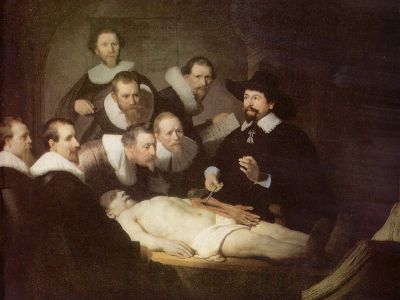
An autopsy, also known as a postmortem examination or an obduction, is a medical procedure that consists of a thorough examination of a human corpse to determine the cause and manner of a person's death and to evaluate any disease or injury that may be present. It is usually performed by a specialized medical doctor called a pathologist.
Autopsies are either performed for legal or medical purposes. A forensic autopsy is carried out when the cause of death may be a criminal matter, while a clinical or academic autopsy is performed to find the medical cause of death and is used in cases of unknown or uncertain death, or for research purposes. Autopsies can be further classified into cases where external examination suffices, and those where the body is dissected and an internal examination is conducted. Permission from next of kin may be required for internal autopsy in some cases. Once an internal autopsy is complete the body is reconstituted by sewing it back together.
A necropsy is a postmortem examination performed on a non-human animal, such as a race horse or a pet.
Life extension
Life extension refers to an increase in maximum or average lifespan, especially in humans, by slowing down or reversing the processes of aging. Average lifespan is determined by vulnerability to accidents and age-related afflictions such as cancer or cardiovascular disease. Extension of average lifespan can be achieved by good diet, exercise, and avoidance of hazards such as smoking and excessive eating of sugar-containing foods. Maximum lifespan is determined by the rate of aging for a species inherent in its genes. Currently, the only widely recognized method of extending maximum lifespan is calorie restriction. Theoretically, extension of maximum lifespan can be achieved by reducing the rate of aging damage, by periodic replacement of damaged tissues, or by molecular repair or rejuvenation of deteriorated cells and tissues.
Researchers of life extension are a subclass of biogerontologists known as "biomedical gerontologists." They seek to understand the nature of aging and they develop treatments to reverse aging processes or to at least slow them down, for the improvement of health and the maintenance of youthful vigor at every stage of life.
Many biomedical gerontologists believe that future breakthroughs in tissue rejuvenation with stem cells, organs replacement (with artificial organs or xenotransplantations) and molecular repair will eliminate all aging and disease as well as allow for complete rejuvenation to a youthful condition. Some life extensionists arrange to be cryonically preserved upon legal death so that they can await the time when future medicine can eliminate disease, rejuvenate them to a lasting youthful condition, and repair damage caused by the cryonics process. Whether the maximum human lifespan should be extended is the subject of much ethical debate amongst politicians and scientists.
Death in Culture
Death has a unique image in global culture. It is respected and feared throughout the world. The unknown aspects of death have produced a type of fascination that many take to extreme levels.
Settlement of dead bodies
In most cultures, before the onset of significant decay, the body undergoes some type of ritual disposal, usually either cremation or interment in a tomb. Cremation is a very old and quite common custom. The act of cremation exemplifies the belief of the concept of "ashes to ashes." The other modes of disposal include interment in a grave, but may also be a sarcophagus, crypt, sepulchre, or ossuary, a mound or barrow, or a monumental surface structure such as a mausoleum (exemplified by the Taj Mahal) or a pyramid (as exemplified by the Great Pyramid of Giza).
In Tibet, one method of corpse disposal is sky burial, which involves placing the body of the deceased on high ground (a mountain) and leaving it for birds of prey to dispose of. Sometimes this is because in certain religious views, birds of prey are carriers of the soul to the heavens. Other times this simply reflects the fact that when terrain (as in Tibet) makes the ground too hard to dig, there are few trees around to burn and the local religion (Buddhism) believes that the body after death is only an empty shell and so leaving it for animals to consume is a practical disposal method.
In certain cultures, efforts are made to retard the decay processes before burial (resulting even in the retardation of decay processes after the burial), as in mummification or embalming. This happens during or after a funeral ceremony.
Graves are usually grouped together in a plot of land called a cemetery or graveyard, and burials can be arranged by a funeral home, mortuary, undertaker, or by a religious body such as a church or the community's burial society, a charitable or voluntary body charged with these duties.
A variety of funeral customs exist in different cultures. In some fishing or naval communities, the body is sent into the water, in what is known as burial at sea. Several mountain villages have a tradition of hanging the coffin in woods. Space burial uses a rocket to launch the cremated remains of a body into orbit.
A more recent alternative is ecological burial. This is a sequence of deep-freezing, pulverization by vibration, freeze-drying, removing metals, and burying the resulting powder, which has 30 percent of the body mass.
Cryonics is the process of cryopreservation of a body to liquid nitrogen temperature to stop the natural decay processes that occur after death. Those practicing cryonics hope that future technology will allow the legally deceased person to be restored to life when and if science is able to cure all disease, rejuvenate people to a youthful condition, and repair damage from the cryopreservation process itself.
Whole body donations, made by the donor while living (or by a family member in some cases), are an important source of human cadavers used in medical education and similar training, and in research.
Mourning
Mourning is the process of and practices surrounding death-related grief. The word is also used to describe a cultural complex of behaviors in which the bereaved participate or are expected to participate. Customs vary between different cultures and evolve over time, though many core behaviors remain constant. Wearing dark, somber clothes is one practice followed in many countries, though other forms of dress are also seen. Those most affected by the loss of a loved one often observe a period of grieving, marked by withdrawal from social events and quiet, respectful behavior. People may also follow certain religious traditions for such occasions.
Mourning may also apply to the death of, or anniversary of the passing of, an important individual like a local leader, monarch, religious figure, and so forth. State mourning may occur on such an occasion. In recent years some traditions have given way to less strict practices, though many customs and traditions continue to be followed.
Bereavement, while a normal part of life for most people, carries a degree of risk when limited support is available. Severe reactions to loss may carry over into familial relations and cause trauma for children, spouses and any other family members. Many forms of what are termed 'mental illness' have loss as their root, but covered by many years and circumstances this often goes unnoticed. Issues of personal faith and beliefs may also face challenge, as bereaved persons reassess personal definitions in the face of great pain. While many who grieve are able to work through their loss independently, accessing additional support from bereavement professionals may promote the process of healing. Individual counseling, professional support groups or educational classes, and peer-lead support groups are primary resources available to the bereaved. In some regions local hospice agencies may be an important first contact for those seeking bereavement support.
Philosophy, religion, and mythology
Faith in some form of afterlife is an important aspect of many people's beliefs. Such beliefs are usually manifested as part of a religion, as they pertain to phenomena beyond the ordinary experience of the natural world. For example, one aspect of Hinduism involves belief in a continuing cycle of birth, life, death and rebirth (Samsara) and the liberation from the cycle (Moksha). Other religions focus on an afterlife in Heaven with our Creator God, along with the possibility of eternal damnation in Hell for evildoers. Some believe that one's identity, personality and consciousness continue after death; others believe that the dead merge into a "cosmic consciousness" and thus lose their individuality.
Though various evidence has been advanced to demonstrate the reality of an afterlife, the material or metaphysical existence of an afterlife remains a matter outside the scope of science. Parapsychology, the study of paranormal phenomena, as well as the testimonies of mediums and their clients, have given credence to these beliefs. Although sometimes tainted by fraud, genuine paranormal experiences can be very powerful and can alter a person's beliefs about the finality of death.
The significance of belief in survival after death lies in the impact it can have on values among the living. If death is not the end, then dying is not something to be feared. If one's attitudes and deeds have consequences in a later existence, then one's conduct in life has greater meaning; indeed, viewed from the perspective of eternity, there are many things that are worse than death.
In monotheistic religion, the one God governs both life and death. In polytheistic religions or mythologies which have a complex system of deities governing various natural phenomena and aspects of human life, it is common to have a deity who is assigned the function of presiding over death. Many traditional cultures incorporated a god of death into their mythology or folk religion. As death, along with birth, is among the major parts of human life, these deities may often be one of the most important deities of a religion.
Personification of death
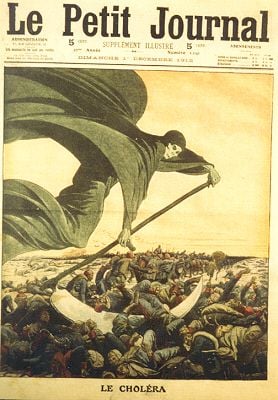
Death has been personified as a figure or fictional character in mythology and popular culture since the earliest days of storytelling. Because the reality of death has had a substantial influence on the human psyche and the development of civilization as a whole, the personification of Death as a living, sentient entity is a concept that has existed in many societies since the beginning of recorded history. In western culture, death is usually shown as a skeletal figure carrying a large scythe, and sometimes wearing a midnight black gown with a hood.
Examples of death personified include:
- In modern-day European-based folklore, Death is known as the "Grim Reaper" or "The grim spectre of death." This form typically wields a scythe, and is sometimes portrayed riding a white horse.
- In the Middle Ages, Death was imagined as a decaying or mummified human corpse, later becoming the familiar skeleton in a robe.
- Death is sometimes portrayed in fiction and occultism as Azrael, the angel of death (note that the name "Azrael" does not appear in any versions of either the Bible or the Qur'an).
- The angel of death is a spirit, deity, or other being whose task is to conduct the souls of the recently dead into the afterlife.
Glorification of and fascination with death
Whether because of its very poetic nature or because of the great mystery it presents, or both, death is and has very often been glorified in many cultures through many different means. War, crime, revenge, martyrdom, suicide, and many other forms of violence involving death are often glorified by different media, often in modern times being glorified even in spite of the attempts at depicting death meant to be de-glorifying. For example, film maker Francis Truffaut has made the claim it is impossible to make an anti-war film, as any depiction of war ends up glorifying it.
The most prevalent and permanent form of death's glorification is through artistic expression. Through song, many artists show death through poetic analogy. Events such as The Charge of the Light Brigade and The Battle of the Alamo have served as inspirations for artistic depictions of and myths regarding death.
Perception of glory in death is subjective and can even differ widely from one member of a group to another. Religion plays a key role, especially in terms of expectations of an afterlife. Personal and perceptions about mode of death are also important factors.
Warfare
War is a prolonged state of violent, large scale conflict involving two or more groups of people, usually leading to the deaths of many. When and how war originated is a highly controversial topic. Often opposing leaders or governing bodies enlist other people to fight for them, even if those fighting have no vested interest in the issues fought over. In time it became practical for some people to have warfare as their sole occupation, either as a member of a military force or mercenary.
The factors leading to war are often complicated and due to a range of issues. Where disputes arise over issues such as sovereignty, territory, resources, ideology and a peaceable resolution is not sought, fails, or is thwarted, war often results. A war may begin following an official declaration of war in the case of international war, although this has not always been observed. Civil wars and revolutions are not usually initiated by a formal declaration of war, but sometimes a statement about the purposes of the fighting is made. Such statements may be interpreted to be declarations of war, or at least a willingness to fight and die for a cause. Genocide is the attempted slaughter of an entire sect of people.
Military suicide and suicide attacks
A suicide attack occurs when an individual or group violently sacrifice their own lives for the benefit of their side. In the desperate final days of World War II, many Japanese pilots volunteered for kamikaze missions in an attempt to forestall defeat for the Empire. In Nazi Germany, Luftwaffe squadrons were formed to smash into American B-17s during daylight bombing missions, in order to delay the highly-probable Allied victory, although in this case, inspiration was primarily the Soviet and Polish taran ramming attacks, and death of the pilot was not a desired outcome.
Suicide has been fairly common in warfare throughout history. Soldiers and civilians committed suicide to avoid capture and slavery (including the wave of German and Japanese suicides in the last days of World War II). Commanders committed suicide rather than accept defeat. Spies and officers have committed suicide to avoid revealing secrets under interrogation and/or torture. Behavior that could be seen as suicidal occurred often in battle. Japanese infantrymen usually fought to the last man, launched "banzai" suicide charges, and committed suicide during the Pacific island battles in World War II. In Saipan and Okinawa, civilians joined in the suicides. Suicidal attacks by pilots were common in the twentieth century: the attack by U.S. torpedo planes at the Battle of Midway was very similar to a kamikaze attack.
Martyrdom
A martyr is a person who is put to death or endures suffering for their beliefs, principles, or ideology. The death of a martyr or the value attributed to it is called martyrdom. In different belief systems, the criteria for being considered a martyr is different. In the Christian context, a martyr is an innocent person who, without seeking death, is murdered or put to death for his or her religious faith or convictions. An example is the persecution of early Christians in the Roman Empire. Christian martyrs sometimes decline to defend themselves at all, in what they see as an imitation of Jesus' willing sacrifice.
Islam accepts a broader view of what constitutes a martyr, including anyone who dies in the struggle between those lands under Muslim government and those areas outside Muslim rule. Generally, some seek to include suicide bombers as a "martyr" of Islam, however, this is widely disputed in mainstream Islamic thought, which argues that a martyr may not commit suicide.
Though often religious in nature, martyrdom can be applied to a secular context as well. The term is sometimes applied to those who die or are otherwise severely affected in support of a cause, such as soldiers fighting in a war, doctors fighting an epidemic, or people leading civil rights movements. Proclaiming martyrdom is a common way to draw attention to a cause and garner support.
Intentional Deaths
Suicide
Suicide is the act of intentionally taking one's own life. Views on suicide have been influenced by cultural views on existential themes such as religion, honor, and the meaning of life. Most Western and Asian religions—the Abrahamic religions, Buddhism, Hinduism—consider suicide a dishonorable act; in the West it was regarded as a serious crime and offense against God due to religious belief in the sanctity of life. An honorable exception is suicide in the midst of battle, to avoid being taken prisoner and dishonored by the enemy, as in the case of king Saul and the defenders of Masada. Japanese views on honor and religion led to seppuku being respected as a means to atone for mistakes or failure during the samurai era. In the twentieth century suicide in the form of self-immolation has been used as a form of protest. Self-sacrifice for others is not usually considered suicide.
Modern medicine regards suicide as a mental health concern, associated with psychological factors such as the difficulty of coping with depression, inescapable pain or fear, or other mental disorders and pressures. Suicide is often interpreted as a "cry for help" and attention, or to express despair and the wish to escape, rather than a genuine intent to die. Most suicides (for various reasons) do not succeed on a first attempt; those who later gain a history of repetitions are significantly more at risk of eventual completion.[12] Nearly a million people worldwide die by suicide annually. While completed suicides are higher in men, women have higher rates for suicide attempts. Elderly males have the highest suicide rate, although rates for young adults have been increasing.[13]
Euthanasia
Euthanasia is the practice of terminating the life of a person or animal in a painless or minimally painful way in order to prevent suffering or other undesired conditions in life. This may be voluntary or involuntary, and carried out with or without a physician. In a medical environment, it is normally carried out by oral, intravenous, or intramuscular drug administration.
Laws around the world vary greatly with regard to euthanasia and are subject to change as people's values shift and better palliative care or treatments become available. It is legal in some nations, while in others it may be criminalized. Due to the gravity of the issue, strict restrictions and proceedings are enforced regardless of legal status. Euthanasia is a controversial issue because of conflicting moral feelings both within a person's own beliefs and between different cultures, ethnicities, religions, and other groups. The subject is explored by the mass media, authors, film makers, and philosophers, and is the source of ongoing debate.
Sacrifices
Sacrifice ("to make sacred") includes the practice of offering the lives of animals or people to the gods, as an act of propitiation or worship. The practice of sacrifice is found in the oldest human records, and the archaeological record finds corpses, both animal and human, that show marks of having been sacrificed and have been dated to long before any records. Human sacrifice was practiced in many ancient cultures. The practice has varied between different civilizations, with some like the Aztecs being notorious for their ritual killings, while others have looked down on the practice. Victims ranging from prisoners to infants to virgins were killed to please their gods, suffering such fates as burning, beheading, and being buried alive.
Animal sacrifice is the ritual killing of an animal as practiced by many religions as a means of appeasing a god or spiritual being, changing the course of nature or divining the future. Animal sacrifice has occurred in almost all cultures, from the Hebrews to the Greeks and Romans to the Yoruba. Over time human and animal sacrifices have become less common in the world, such that modern sacrifices are rare. Most religions condemn the practice of human sacrifices, and present day laws generally treat them as a criminal matter. Nonetheless traditional sacrifice rituals are still seen in less developed areas of the world where traditional beliefs and superstitions linger, including the sacrifice of human beings.
Homicide
Homicide is the illegal killing, when intentional the murder, of another person. It has various degrees of intention and stances before the law. Each of these different stances carries different penalties.
Capital punishment
Capital punishment, also known as the death penalty, is the execution of a convicted criminal by the state as punishment for crimes known as capital crimes or capital offenses. Historically, the execution of criminals and political opponents was used by nearly all societies—both to punish crime and to suppress political dissent.
In most places that practice capital punishment today, the death penalty is reserved as punishment for premeditated murder, espionage, treason, or as part of military justice. In some countries, sexual crimes, such as adultery and sodomy, carry the death penalty, as do religious crimes such as apostasy, the formal renunciation of one's religion. Drug trafficking and human trafficking may also be considered capital offenses. In militaries around the world courts-martial have imposed death sentences for offenses such as cowardice, desertion, insubordination, and mutiny.[14]
Methods of capital punishment have varied from culture to culture throughout history. They have ranged from the deliberately painful and humiliating (drawing and quartering), to those designed for greater expediency (the guillotine), the standard method (hanging), to those intended to be quick and humane (electric chair, lethal injection).
Legal Settlement
Aside from the physical disposition of the corpse, the estate of a person must be settled. This includes all of the person's legal rights and obligations, such as assets and debts. Depending on the jurisdiction, laws or a will may determine the final disposition of the estate. A legal process, such as probate, guides these proceedings.
Preparation for death
In most circumstances death is a process rather than an event. The majority of people do not die suddenly. Even though the number who have died in warfare and accidents is quite large, not all die instantaneously; many suffer fatal wounds and subsequent death. Death is universal; we all have time to prepare for it since we know it is inevitable.
Before death arrives, people make many preparations. These include writing a last will and testament or giving away items of value to family and friends; setting one's affairs in order so that next of kin who may be upset by their loss have less stress; social and emotional matters like mending broken relationships, affirming love for family and friends, and so forth.
There are also many things people may do to complete personal goals—travel to a place one has often dreamed of visiting, attend a special event, complete a work of art or literature, to name a few. With less warning or serious illness of course many of these activities would not be possible. For many, religious rituals are to be completed prior to death, if possible.
Ultimately, however, since the time of our death is not known to us, our whole life is, in a sense, preparation for our death. Thus, the best preparation for death is to live one's life to the fullest, and so to have no regrets when the time comes to leave the physical world. Then, if there is an afterlife, we are well prepared for it. In a letter to a child with cancer, Elisabeth Kübler-Ross, thanatologist and acclaimed author of On Death and Dying, wrote:
When we have done all the work we were sent to Earth to do, we are allowed to shed out body, which imprisons our soul like a cocoon encloses the future butterfly. And when the time is right, we can let go of it and we will be free of pain, free of fears and worries—free as a very beautiful butterfly, returning home to God...which is a place where we are never alone, where we continue to grow and to sing and to dance, where we are with those we loved, and where we are surrounded with more love than we can ever imagine.
Notable quotations
- Death is no more than a separation of the body from the soul, which is immortal and imperishable. And at death, the guardian spirit who is allotted to each man for life, leads him to his proper dwelling place according to the life he has lived on earth. (Socrates)
- Look forward without fear to that appointed hour—the last hour of the body, but not of the soul; That day which you may fear as being the end of all things, is the birthday of your eternity. (Seneca)
- I am convinced that it is hygenic, if I may use the word, to discover in death a goal toward which one can strive, and that shrinking away from it is something unhealthy and abnormal, which robs the second half of life of its purpose. Only that which is psychic has direct reality. The psychic is no exception to the general rule that the universe can be established only insofar as our psychic organ permits. (Carl Jung)
- This life is rather an embryo state; a preparation for living. A man is not completely born until he dies. Why, then, should we grieve that a new child is born among the immortals—a new member added to their happy society. We are all spirits. That bodies should be lent to us while they can afford us pleasure, assisting us in acquiring knowledge, or in doing good for our fellow creatures, is a kind of benevolent act of God. When the body becomes unfit for these purposes and affords us pain instead of pleasure, and instead of an aid becomes an encumbrance, and answers none of the intentions for which it was given, it is equally kind and benevolent that a way is provided by which we get rid of it. Death is that way. (Benjamin Franklin, 1756)
Notes
- ↑ Dority v. Superior Court (Kottmeier) (1983) 145 Cal. App. 3d 273 [193 Cal. Rptr. 288 Retrieved July 26, 2021.
- ↑ Leonard F. DeBano, Daniel G. Neary, and Peter F. Folliott, Fire’s Effects on Ecosystems (Wiley, 1998, ISBN 978-0471163565).
- ↑ Jared Diamond, "Up to the Starting Line" in Guns, Germs, and Steel (New York: W. W. Norton, 1999, ISBN 0393317552), 43-44.
- ↑ David M. Raup, Extinction: Bad Genes or Bad Luck? (New York, NY: W.W. Norton and Company, 1991, ISBN 978-0393309270), 3-6.
- ↑ A grain of hope in the desert IUCN, June 16, 2011. Retrieved July 26, 2021.
- ↑ E.O. Wilson, The Future of Life (New York: Vintage, 2003, ISBN 0679768114).
- ↑ Richard Leakey, The Sixth Extinction: Patterns of Life and the Future of Humankind (Anchor, 1996, ISBN 0385468091).
- ↑ 8.0 8.1 8.2 Daniel Limmer and Michael F. O'Keefe, Emergency care (Prentice Hall, 2008, ISBN 978-0135005231).
- ↑ Bill Hoffmann, Blood Swapping Reanimates Dead Dogs Fox News, June 28, 2005. Retrieved July 26, 2021.
- ↑ Tuberculosis Key Facts World Health Organization (WHO), October 14, 2020. Retrieved July 26, 2021.
- ↑ S.J. Olshanksy, Daniel Perry, Richard A. Miller, and Robert N. Butler, In Pursuit of the Longevity Dividend: What Should We Be Doing To Prepare for the Unprecedented Aging of Humanity? The Scientist 20(2006): 28-36. Retrieved July 26, 2021.
- ↑ D.J. Shaffer, The Epidemiology of Teen Suicide: An Examination of Risk Factors Journal of Clinical Psychiatry 49 (1988): 36-41. Retrieved July 26, 2021.
- ↑ Maya Schwartz-Lifshitz, Gil Zalsman, Lucas Giner, and Maria A. Oquendo, Can We Really Prevent Suicide? Curr Psychiatry Rep. 14(6) (2012): 624–633. Retrieved July 26, 2021.
- ↑ Shot at dawn, pardoned 90 years on. BBC News, August 16, 2006. Retrieved July 26, 2021.
ReferencesISBN links support NWE through referral fees
- Baden, Michael. Unnatural Death: Confessions of a Medical Examiner. Ballantine Books, 1990. ISBN 0804105995
- Becker, Ernest. The Denial of Death. Free Press, 1997. ISBN 0684832402
- Cook, C. Death in Ancient China: The Tale of One Man's Journey. Brill Publishers, 2006. ISBN 9004153128
- DeBano, Leonard F., Daniel G. Neary, and Peter F. Ffolliott. Fire’s Effects on Ecosystems. Wiley, 1998. ISBN 978-0471163565
- Despelder, Lynne Ann. The Last Dance: Encountering Death and Dying. McGraw Hill, 2004. ISBN 0072920963
- Diamond, Jared. Guns, Germs, and Steel. New York, NY: W.W. Norton, 1999. ISBN 0393317552
- Kubler-Ross, Elisabeth. On Death and Dying. Scribner, 1997. ISBN 0684842238
- Leakey, Richard. The Sixth Extinction: Patterns of Life and the Future of Humankind. Anchor, 1996. ISBN 0385468091
- Limmer, Daniel, and Michael F. O'Keefe. Emergency care. Prentice Hall, 2008. ISBN 978-0135005231
- Maloney, George, A. The Everlasting Now: Meditations on the mysteries of life and death as they touch us in our daily lives. Ave Maria Press, 1980. ISBN 0877932018
- Raup, David M. Extinction: Bad Genes or Bad Luck? New York, NY: W.W. Norton and Company, 1991. ISBN 978-0393309270
- Roach, Mary. Stiff: The Curious Lives of Human Cadavers. New York, NY: W.W. Norton & Company, 2004. ISBN 0393324826
- Wilson, E.O. The Future of Life. New York: Vintage, 2003. ISBN 0679768114
External links
All links retrieved June 27, 2022.
- Death Stanford Encyclopedia of Philosophy
- Causes of Death
- Causes of death over 100 years
- George Wald: The Origin of Death A biologist explains life and death in different kinds of organisms in relation to evolution.
| |||||||||||||||||
Credits
New World Encyclopedia writers and editors rewrote and completed the Wikipedia article in accordance with New World Encyclopedia standards. This article abides by terms of the Creative Commons CC-by-sa 3.0 License (CC-by-sa), which may be used and disseminated with proper attribution. Credit is due under the terms of this license that can reference both the New World Encyclopedia contributors and the selfless volunteer contributors of the Wikimedia Foundation. To cite this article click here for a list of acceptable citing formats.The history of earlier contributions by wikipedians is accessible to researchers here:
The history of this article since it was imported to New World Encyclopedia:
Note: Some restrictions may apply to use of individual images which are separately licensed.








